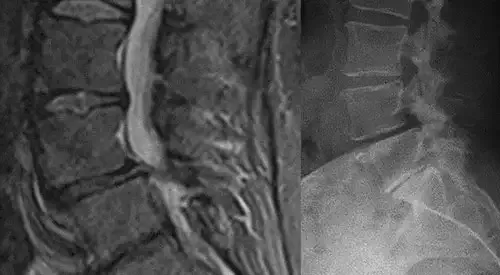Spondylolisthesis
"The surgery significantly improves the symptoms but the patient must continue to take care of himself with guidelines of postural hygiene, healthy diet and active life".
DR. VÍCTOR RODRIGO
DIRECTOR. NEUROSURGERY DEPARTMENT

Spondylolisthesis is the displacement of one vertebra over another and is numbered up to 5 degrees according to the distance it has slipped (Grade I is the minimum and grade 5 the maximum or spondylolisthesis).
When the displacement of the vertebra occurs forward is called anterolysis and backward, retrolistesis. If it slips too much, the bone can trap the cord or nerves.
It can be unstable and cause canal stenosis and/or low back pain with movement or standing.
It occurs most frequently in lumbar segments, especially in the latter (L4-L5-S1). Although it can also occur at the cervical level.

What are the symptoms of spondylolisthesis?
The symptomatology that can give a spondylolisthesis is so much a radiculopathy (pain in the legs if it is lumbar or in arms if it is cervical) as if it was a disc herniation, or claudication of the march as a stenosis of channel (link).
Also they are in the habit of being diagnosed as a result of a lumbar pain with irradiation to gluteus, for overload.
In most cases the patient refers more pain when standing or walking.
In severe cases it can cause instability in the walk, sensory disorders and even incontinence.
The most common symptoms are:
- Pain in legs or arms (depending on location).
- Pain radiating to the buttocks.
- Instability of the walk, sensory disorders and / or incontinence.
Do you have any of these symptoms?
You may have a spondylolisthesis
How is spondylolisthesis diagnosed?

It can be diagnosed with a simple lumbar x-ray, although it is usually complemented with functional or dynamic x-rays and magnetic resonance imaging (MRI), CT or scanner.
Depending on the origin of the list, it can be divided into:
- Degenerative: due to degeneration of the tissues that stabilize the vertebrae (intervertebral disc, ligaments, facet joints, etc.).
- Isthmic: due to spondylolysis, which are traces of a fracture or weakness in an area of the vertebra called "pars intearticularis", which causes insufficient support and consequent slippage.
- Traumatic: due to a blow, fall or accident.
- Congenital: present from birth, it causes a deformity in the bones.P
- Pathological: due to a bone disease, for example, a tumor.
- Iatrogenic: surgery that weakens the bone structures that stabilize the vertebrae, can cause spondylolisthesis.
How is spondylolisthesis treated?
The initial treatment is usually conservative with drugs and physical exercise aimed at strengthening the spine muscles. In the event that the pain is unbearable, refractory to medical treatment and/or has already caused a motor deficit, the indication for surgery will be established.
Frequently, a decompression of the same level is also necessary, since the facet or posterior articulations and their adjacent tissues, hypertrophy conditions a notable decrease of the spinal canal and the conjunction holes.
It is generally performed posteriorly and can be complemented with an intersomatic device (between the vertebral bodies) to increase stability, increase the space where the nerve roots meet and ensure fusion. In cervical cases, the approach is usually anterior.
Where do we treat it?
IN NAVARRE AND MADRID



